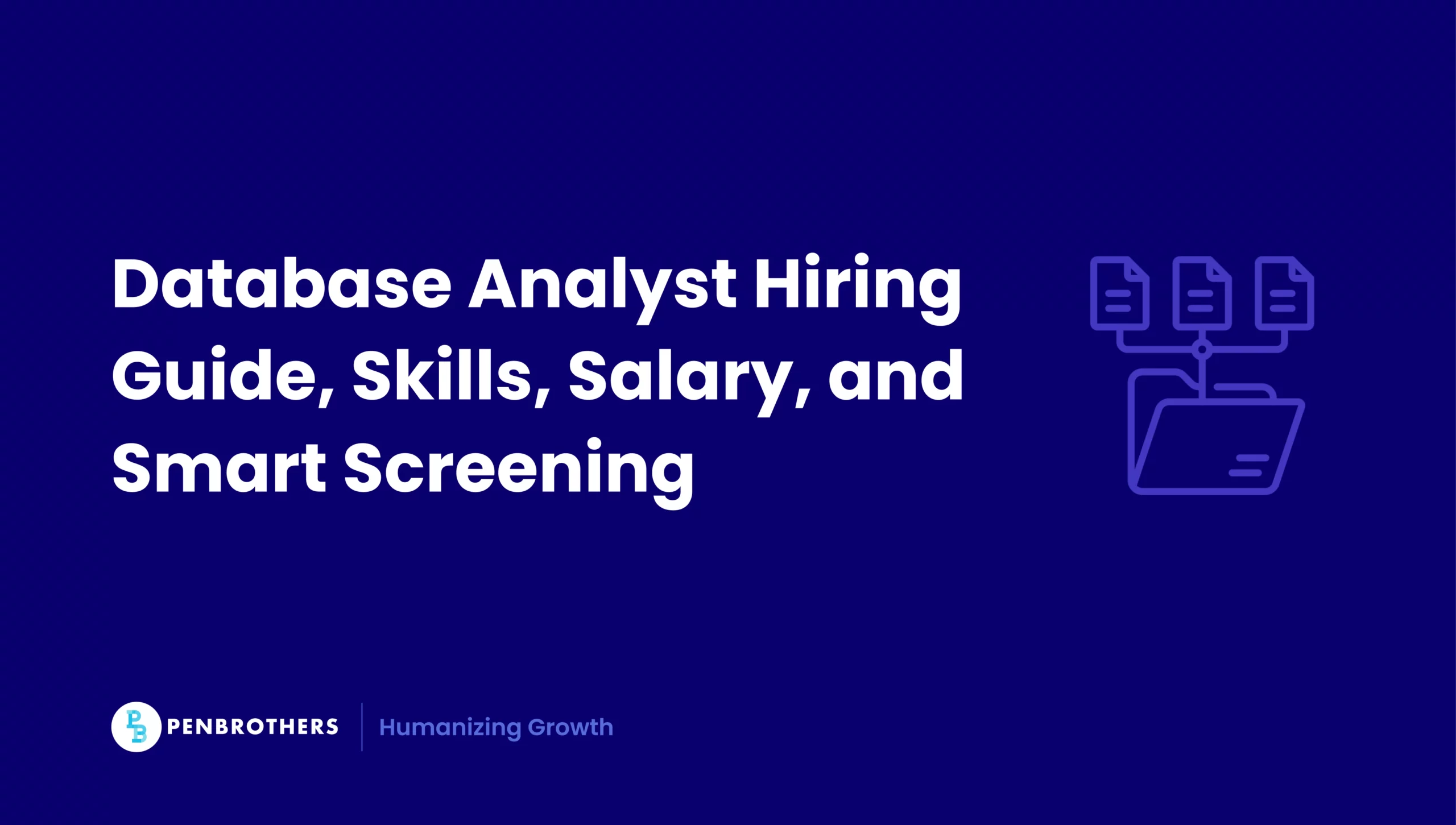What's Inside?
Database Analyst: Role, Skills, Salary, and How to Hire Right

The query has been running for eleven minutes. Nobody speaks. The weekly leadership meeting sits frozen on slide three because the revenue numbers won’t load. Someone suggests refreshing. Someone else suggests waiting. The CFO checks her phone. Your head of engineering opens Slack, scrolls through the performance monitoring channel, sees nothing unusual. The database isn’t down. The servers aren’t on fire. Everything looks fine except for this one thing: the data won’t come.
This is what it looks like when you don’t have a database analyst. Not a catastrophe. Just slow erosion. Death by a thousand timeouts.
TL;DR for Busy Executives
- A database analyst designs, optimizes, and maintains the structures and queries that power your critical reports and applications. They make data fast, reliable, and usable.
- Hire this role when slow queries, timeouts, inconsistent numbers, or low data trust are blocking growth. Choose a database analyst for modeling and performance, a DBA for administration and uptime, and a data analyst for insights and dashboards.
- How much do database analysts make: the closest U.S. federal benchmark is the BLS category “Database Administrators and Architects,” $123,100 median (May 2024). The Philippines offers a large talent pool with materially lower costs; see the table below for current deltas.
- This guide includes a step-by-step hiring plan, structured interview kit, a 30-60-90 onboarding plan, and measurable KPIs.
Definition, Scope, and Where This Role Sits
Here’s what a database analyst actually does: they make your database work the way it should have worked in the first place.
They’re the person who looks at a query that takes four minutes to run and rewrites it to finish in four seconds. They design table structures so your data stays consistent. They build indexes so your application doesn’t crawl through millions of rows every time someone searches for a customer name. They enforce rules so finance and sales can’t report different revenue numbers from the same database.
The confusion starts because there are three roles that sound similar but do entirely different work. Let me draw the lines clearly.
Database Analyst vs Data Analyst: The database analyst builds the foundation. The data analyst stands on that foundation and tells you what the numbers mean. One is an engineer. One is an interpreter. You need both, but they’re not interchangeable.
Database Analyst vs DBA: The database analyst tunes queries, designs schemas, and makes sure your data model makes sense. The DBA keeps the database server running, handles backups, manages user permissions, and gets paged at 3 a.m. when something breaks. The analyst makes things fast. The DBA makes things available.
Get this wrong and you’ll hire someone who can build dashboards but can’t fix a slow join. Or someone who can restore a backup but can’t tell you why your queries are scanning entire tables instead of using an index.
The database analyst reports to engineering or data, depending on your structure. Stakeholders include product, finance, operations, and anyone who depends on data being correct and fast. Which, in a functioning company, is everyone.
The role owns schema changes, indexing strategy, and query performance standards. They don’t own the infrastructure (that’s the DBA) and they don’t own business insights (that’s the data analyst). They own the space between raw storage and useful information.
What Do Database Analysts Do, Day to Day
The work looks different every day, but the pattern holds: someone has a problem with data, and the database analyst makes it not a problem anymore.
They translate business questions into efficient SQL. A product manager wants to know which customers haven’t logged in for 90 days. Simple ask. But if you write that query badly, it locks tables and times out. A good database analyst writes it correctly the first time.
They optimize indexes and query plans. Your search feature works fine with 10,000 users. At 100,000 users it falls over. The database analyst figures out which index you’re missing, where your joins are inefficient, and why the query planner chose a table scan when it should have used an index seek.
They maintain data quality through constraints and validation. Two systems feed the same database. One sends customer IDs as integers, one as strings. Orders get orphaned because the foreign key fails. The database analyst catches this, fixes it, and builds rules so it can’t happen again.
They document everything. Data dictionaries, entity relationship diagrams, migration procedures. Not because they love documentation, but because the next person (or their future self) needs to understand what lives where and why.
They collaborate. With engineers who need schemas for new features. With data analysts who need their queries to run faster. With operations teams who need reliable data pipelines. The database analyst sits at the intersection of all these conversations.
The business outcomes are concrete. Applications respond faster. Cloud bills drop because queries use fewer resources. Reports run overnight instead of timing out. Teams make decisions on numbers they can trust. The database stops being a bottleneck and starts being an asset.
The U.S. Bureau of Labor Statistics tracks this work under “Database Administrators and Architects.” DB-Engines publishes rankings of database management systems by popularity. The Stack Overflow Developer Survey 2025 shows what databases developers actually use and prefer. All useful context for understanding where this role fits in the current technology market.
Core Skills and Tools (Executive View)
The central skill is SQL. Not basic SQL. Advanced SQL. The kind where you can read a query execution plan, understand why the optimizer made the choices it made, and rewrite the query so it makes better choices.
This means understanding normalization, knowing when to denormalize, designing indexes that cover your most expensive queries, partitioning large tables, and recognizing when a stored procedure will perform better than application-level logic.
The technical depth extends to database management systems. PostgreSQL, Microsoft SQL Server, Oracle. Each has its own dialect, its own optimizer behavior, its own tooling. A strong candidate knows at least one deeply and can adapt to others. According to the Stack Overflow survey, PostgreSQL leads in developer preference at 55.6%, followed by MySQL at 40.5%. The DB-Engines ranking shows Oracle, MySQL, and SQL Server still dominate enterprise installations, but PostgreSQL keeps rising.
This creates a gap. Legacy systems run on commercial databases. New systems prefer open source. A database analyst who bridges both worlds is valuable.
Beyond SQL and system-specific knowledge: data modeling for transactional systems and analytics, ETL fundamentals, version control for schema changes, and basic scripting for automation.
On the governance side: understanding constraints and referential integrity, implementing audit trails, designing role-based access controls, and documenting everything clearly enough that someone else can understand it six months later.
Communication matters more than most technical roles. A database analyst needs to challenge incomplete requirements, explain performance trade-offs without jargon, and align stakeholders who care about different things. Finance wants accuracy. Engineering wants speed. Product wants features. The database analyst makes all three possible, but not by magic. By asking better questions up front.
Business Cases and ROI
You need a database analyst when the cost of not having one exceeds the cost of the hire. That threshold arrives faster than most companies expect.
Signs you’ve crossed it: reports that used to finish now time out. Customer-facing features feel slow. Your cloud database bill keeps climbing even though traffic stayed flat. Engineering spends half their sprint fighting database performance instead of shipping features. Finance and sales argue about whose revenue numbers are correct because the same query returns different results depending on how you write it.
The ROI shows up in measurements. Query latency drops. The 95th percentile response time for your most expensive queries goes from 8 seconds to 800 milliseconds. You stop doing full table scans on tables with 50 million rows. Database CPU usage falls by 40% because indexes are covering your queries correctly now. ETL jobs that used to fail twice a week run clean.
Less obvious but equally important: trust in data improves. When numbers reconcile consistently, people stop building shadow spreadsheets and manual checks. They use the dashboard. Decisions get faster. Fewer meetings spent arguing about whose version of the truth is right.
The cost reduction compounds. Better queries mean smaller database instances, which means lower monthly bills. Fewer timeouts mean fewer support tickets and angry customers. Clean data means less time spent on manual reconciliation. Reliable pipelines mean fewer 2 a.m. pages to fix broken jobs.
Most companies hire data analysts and data scientists before they hire a database analyst. This is backwards. If your database foundation is slow and unreliable, all that downstream analysis sits on quicksand. No amount of machine learning fixes a bad data model. No visualization tool makes up for queries that don’t finish.
Get the foundation right first. Then build on it.
How Much Do Database Analysts Make
The U.S. Bureau of Labor Statistics doesn’t track “Database Analyst” as a distinct category. The closest match is “Database Administrators and Architects” (SOC Code 15-1245), which includes the core responsibilities of designing, implementing, maintaining, and securing data systems.
As of May 2024, the median annual wage for this category was $123,100.
The BLS provides more granular data from May 2023 (the most recent detailed figures available):
- Database Administrators (SOC 15-1242): 25th percentile at $71,940, 75th percentile at $133,120
- Database Architects (SOC 15-1243): 25th percentile at $104,330, 75th percentile at $166,780
A typical mid-to-senior database analyst falls somewhere in the combined range of roughly $72,000 to $167,000 annually.
Several factors push compensation higher: depth of SQL and tuning expertise, complexity of the environment (regulated industries, high-transaction systems), on-call requirements, and the ability to drive technical change across teams.
A note on methodology: because “database analyst” lacks a standardized title across employers, this analysis maps to the most authoritative federal category available and cross-checks with market signals.
U.S. vs Philippines Salary Comparison
The compensation gap between the U.S. and the Philippines markets is substantial. But the title matters more than most people realize.
In the Philippines, job boards and salary aggregators frequently conflate “Data Analyst” (business intelligence and reporting) with “Database Analyst” (technical database work). The skill sets differ. So do the salaries.
If you want someone who can tune queries and design schemas, you’re looking at “Database Administrator” or “SQL Database Administrator” titles in the Philippines market, not “Data Analyst.” Trying to save money by hiring at the lower “Data Analyst” rate gets you someone without the technical depth you need. That’s not a bargain. That’s a mis-hire.
The research below uses a working exchange rate of 1 USD = 58 PHP for comparison across sources.
| Role Title | Source | Date | Currency | Annual Salary (Local) | Annual Salary (USD) | Notes |
| US: Database Administrators and Architects (Median) | U.S. BLS OOH | May 2024 | USD | $123,100 | $123,100 | Closest official category to “database analyst.” |
| US: Database Administrators and Architects (25th-75th %) | U.S. BLS | May 2023 | USD | $71,940 – $166,780 | $71,940 – $166,780 | Range derived from sub-categories. |
| PH: Data Analyst (Median) | Nodeflair | 2025 | PHP | ₱438,000 (₱36.5k/mo) | ~$7,550 | Based on anonymous submissions. Title is “Data Analyst,” likely skewed towards BI/reporting skills. |
| PH: Database Administrator (DBA) (Median) | Payscale | 2025 | PHP | ₱461,370 | ~$7,950 | Closer proxy for technical database role. |
| PH: Database Administrator (DBA) (Range) | Jobstreet PH | Oct 2025 | PHP | ₱756,000 – ₱876,000 | ~$13,030 – $15,100 | Significantly higher than “Data Analyst,” indicating a more senior/technical role. |
| PH: SQL Database Administrator (Median) | SalaryExpert | 2025 | PHP | ₱883,501 | ~$15,230 | Specific “SQL DBA” title is a strong match for database analyst skill set. |
| PH: Database Administrator | Penbrothers Salary Guide | 2025 | USD | $25,200 – $34,800 | ~$25,200 – $34,800 | Source provides a monthly range of $2,100 – $2,900. Strongest proxy for a technical Database Analyst. |
Monthly view:
- U.S.: ~$10,258 per month
- Philippines (DBA level): ~$2,100 to $2,900 per month
The cost savings are real, with compensation being roughly 20 to 30 percent of the U.S. median. But you have to budget for the right title. The Philippines has a mature IT and BPO sector with strong English proficiency and deep technical talent. Finding that talent requires screening for performance tuning skills specifically, not just general data work.
The time zone difference (12 to 15 hours ahead of U.S. time zones) becomes an advantage if you structure it correctly. A few hours of daily overlap for meetings and collaboration, then the analyst works during U.S. off-hours. Database maintenance, index rebuilds, performance tuning, all the resource-intensive work that you’d rather not run during business hours anyway. The offset stops being a problem and starts being a feature.
Security and access control matter regardless of location. Least privilege, comprehensive logging, and proper change control from day one. Don’t treat offshore team members differently from onshore in terms of process rigor. Same standards, same documentation, same review procedures.
How to Hire a Database Analyst, Step by Step
Hiring well starts with being clear about what you actually need. Most companies aren’t clear. They know something is wrong with their database performance, but they haven’t translated that pain into a concrete role definition.
Step one: scope the need. Write down the specific problems you’re trying to solve. “Our quarterly revenue report times out” is a problem. “Data is messy” is not specific enough. List the outcomes you expect in 90 days. Then work backwards to define the role.
Step two: choose the title and reporting line. “Database Analyst” reporting to Engineering or Data works for most companies. If the person will drive database strategy across multiple teams and services, consider “Database Architect” or “Senior Database Analyst.” Title matters for attracting the right candidates.
Step three: write the job description. Most job descriptions for this role are terrible. They list twenty technologies and ten years of experience and read like they were assembled from a dozen other postings. Write yours clearly.
Here’s a template that works:
Responsibilities:
- Design and maintain database schemas that support business requirements
- Write and optimize complex SQL queries, stored procedures, and functions
- Implement indexing strategies to improve query performance
- Ensure data integrity through constraints, validation rules, and documentation
- Collaborate with engineering, analytics, and operations teams on data architecture
- Monitor database performance and proactively identify optimization opportunities
- Document data models, lineage, and standards
Required skills:
- Advanced SQL, including query optimization and execution plan analysis
- Data modeling and normalization (at least 3rd Normal Form)
- Hands-on experience with at least one major DBMS (PostgreSQL, SQL Server, or Oracle)
- Demonstrated ability to diagnose and resolve performance bottlenecks
- Clear written and verbal communication
Preferred skills:
- ETL tooling and data warehouse concepts
- Scripting for automation (Python, Bash, or similar)
- Experience with version control for database changes
Soft skills that actually matter:
- Ability to challenge vague requirements and ask clarifying questions
- Comfort explaining technical trade-offs to non-technical stakeholders
- Ownership mindset for production incidents and data quality issues
Step four: sourcing and screening. Look for portfolios or examples that show actual work. Query execution plans, before-and-after performance metrics, schema designs. Not just “I know SQL.” Proof that they’ve made databases faster.
Step five: watch for red flags in resumes. Only dashboarding experience with no evidence of query tuning. Vague claims about “optimizing performance” without numbers. Resumes that list thirty technologies but show no depth in any of them. Long gaps with no explanation.
Interview Kit, Tests, and Scorecards
A good interview process filters for technical depth, problem-solving ability, and communication. Four stages work well.
Stage one: HR screen. Can they communicate clearly? Do their expectations align with the role? Are they genuinely interested in database work or just applying everywhere? This should take 30 minutes and eliminate candidates who aren’t serious.
Stage two: technical screen. SQL fundamentals, normalization concepts, basic troubleshooting. This can happen over a phone call or video with a shared screen. You’re looking for baseline competence, not mastery. 45 minutes.
Stage three: hands-on technical exercise. This is where you actually learn whether they can do the job. Give them a real problem. A slow query, a schema design challenge, a data quality issue. Let them work through it. Watch how they think, not just whether they get the right answer. 60 to 90 minutes.
Stage four: stakeholder interview. Can they explain technical concepts to someone who doesn’t write code? Do they ask questions about business context? Can they prioritize competing requests? This is your CTO or head of engineering plus someone from the business side. 45 minutes.
Ten questions that reveal depth:
- “A marketing manager says their dashboard is too slow. Walk me through how you’d diagnose and fix it.” (Tests communication, systematic thinking, and troubleshooting process.)
- “Explain the difference between second and third normal form. Then tell me about a time you deliberately denormalized a table and why.” (Tests theory and practical judgment.)
- “You have a large Orders table with an index on CustomerID. The query SELECT * FROM Orders WHERE OrderDate > ‘2025-01-01’ is slow. What’s likely wrong and how do you fix it?” (Tests understanding of index selectivity and covering indexes.)
- “You see a query plan with a Table Scan eating 95% of query cost. What does that mean and what are your first two solutions?” (Tests core performance tuning knowledge.)
- “What’s the difference between WHERE and HAVING? When does it matter for performance?” (Tests understanding of SQL execution order.)
- “Write a query to find the employee with the third-highest salary in each department, without using LIMIT or OFFSET.” (Tests window functions like ROW_NUMBER or DENSE_RANK.)
- “Explain LEFT JOIN versus FULL OUTER JOIN. If you LEFT JOIN Table A with 1,000 rows to Table B with 1 million rows on a non-unique key, what’s the maximum number of rows you could get back?” (Tests join logic and cardinality.)
- “Tell me about a data quality issue you found. How did you identify it, what was the business impact, and what did you do to prevent it from happening again?” (Tests problem-solving and proactive thinking.)
- “An overnight batch job that normally takes an hour suddenly took eight hours, with no code changes. What do you investigate first?” (Tests troubleshooting beyond the obvious, statistics, blocking, parameter sniffing.)
- “Beyond fixing problems people report, how would you proactively find database performance issues before they become urgent?” (Tests strategic thinking versus reactive mindset.)
Hands-on exercises:
The best way to evaluate someone’s technical skill is to watch them work. Here are five exercises that reveal competence. Each comes with a scoring rubric.
Exercise one: query optimization. Give them a poorly written query with inefficient subqueries and bad joins. Ask them to rewrite it and explain their changes. Score on correctness (2 points), identification of the worst bottleneck (2 points), and logical efficiency of the final query (1 point). Total: 5 points.
Exercise two: index recommendation. Provide a table schema and five to seven common queries against it. Ask them to recommend indexes and justify each one. Score on correct single-column indexes (2 points), appropriate composite indexes (2 points), and explaining the write-versus-read trade-off (1 point). Total: 5 points.
Exercise three: data modeling. Give them a business scenario like “design a database for a bug tracking system with projects, tickets, users, and comments.” Ask for an entity-relationship diagram. Score on correct entity identification (2 points), proper relationships and foreign keys (2 points), and achieving at least third normal form (1 point). Total: 5 points.
Exercise four: data quality detection. Provide a small dataset (20 rows) with dirty data: duplicates, inconsistent formatting, nulls. Ask them to write a SQL query that identifies and flags the problems. Score on correctly finding duplicates with ROW_NUMBER (2 points), identifying inconsistencies with CASE or string functions (2 points), and producing clear, runnable output (1 point). Total: 5 points.
Exercise five: execution plan analysis. Show them a graphical query execution plan with an expensive Key Lookup. Ask them to explain what’s happening, why the Key Lookup is a problem, and how to fix it. Score on correctly reading the plan flow (2 points), explaining that Key Lookup means the index isn’t covering the query (2 points), and recommending the right fix, adding columns via INCLUDE (1 point). Total: 5 points.
Run three of these five exercises during the technical deep-dive interview. Pick the ones most relevant to your specific database challenges.
Red flags to watch for:
They can explain what a query does but not why it matters to the business. They’ve only worked with clean academic datasets and get uncomfortable when you show them messy real-world data. They treat SQL as a legacy skill and prefer working through ORMs, showing no depth in performance tuning. They don’t ask clarifying questions about the data or business context during exercises. They blame the hardware or the network when facing a performance problem instead of investigating the query first.
Any of these patterns usually leads to an unsuccessful hire.
Onboarding: 30-60-90 Plan
Hiring a good database analyst is the start. Getting them productive quickly requires structure.
Days 1 to 30: learning and discovery
The first month is reconnaissance. The new hire meets key stakeholders, engineering leads, BI team, product managers, operations. They learn what everyone cares about and where the pain lives.
They get access to all relevant systems: databases, monitoring tools, documentation repositories, code repositories. They review existing data models, read what documentation exists (usually less than they’d like), and start building a mental map of how data flows through your organization.
The most important deliverable for month one: identify and document the top five slowest or most resource-intensive queries in production. These become the optimization targets for month two.
Success metrics: all access granted, stakeholder meetings completed, top five problem queries documented and reviewed with their manager.
Days 31 to 60: contribution and initial wins
Month two is about showing value. The analyst optimizes at least two of the top five problem queries identified in month one. They measure and document the improvement. Query execution time drops by 50% or more, resource usage falls, timeouts disappear.
They create or significantly update documentation for one critical database schema. A data dictionary, an entity-relationship diagram, a migration procedure, something that was missing or wrong before.
They collaborate with the development team to troubleshoot and fix a database-related performance issue in pre-production, proving they can work embedded with engineers.
They propose a new indexing strategy for a key table and present the rationale to the team. Not just “add this index,” but “here’s why we need it, here’s the trade-off, here’s how we’ll measure success.”
Success metrics: measurable query improvements delivered, documentation approved by manager, positive feedback from development team, indexing proposal reviewed and approved for implementation.
Days 61 to 90: ownership and proactive improvement
Month three is about scaling impact beyond ticket response. The analyst establishes a recurring process for monitoring and reporting key database performance metrics. They publish the first monthly report.
They develop and publish SQL best practice guidelines for the development team, a living document that codifies standards and common patterns.
They begin scoping and planning a larger data modeling or refactoring project that addresses known architectural debt. Not executing it yet, but defining it clearly enough that leadership can approve resources.
They take ownership of the database performance backlog, prioritizing tickets and driving resolution instead of waiting to be assigned work.
Success metrics: first monthly performance report delivered, best practices guide published to the internal wiki, refactoring project plan drafted and approved, measurable reduction in ad-hoc performance complaints from users.
This 30-60-90 structure gives the new hire clear milestones and gives you clear checkpoints to assess whether the hire is working out.
Engagement Models and Team Design
You can staff this role three ways: in-house U.S. hire, hybrid model, or offshore partner.
In-house U.S. hire gives you time zone overlap and easier collaboration but costs more. Hybrid model (contractor or part-time) works if your database challenges are project-based rather than ongoing. Offshore partner (Philippines being the most common) gives you cost savings and skilled talent if you structure the engagement correctly.
Regardless of model: define clear RACI (Responsible, Accountable, Consulted, Informed) across the database analyst, DBA, and analytics engineering roles. The database analyst owns modeling and tuning. The DBA owns administration and uptime. Analytics engineering owns data pipelines and transformation. These roles overlap but have distinct decision rights.
Enforce least privilege and change control regardless of where your team sits. All schema changes go through code review. All production modifications get logged and approved. Access is granted on a need-to-know basis. Security is not location-dependent.
If you’re building a data team from scratch, hire the database analyst before or alongside your first data analyst. You need the foundation before you can build on it. If you already have data analysts struggling with slow queries and messy data, hiring a database analyst will multiply their effectiveness.
Next Steps
Your database lives at the center of customer experience, financial reporting, and operational decisions. When it’s slow, everything built on top of it is slow. When it’s unreliable, trust erodes. When it’s poorly designed, problems compound until someone finally admits you need to fix the foundation.
Hire a database analyst when speed, reliability, and trust in your numbers start slipping. Structure the role clearly. Test candidates pragmatically with real problems, not theoretical ones. Onboard with intention and clear milestones. Measure what matters: query performance, system stability, data quality, and business impact.
The work is technical, but the outcomes are business outcomes. Faster decisions, lower costs, fewer fires, better products. That’s the return.
Need help building a high-performing database function? Talk to us.




